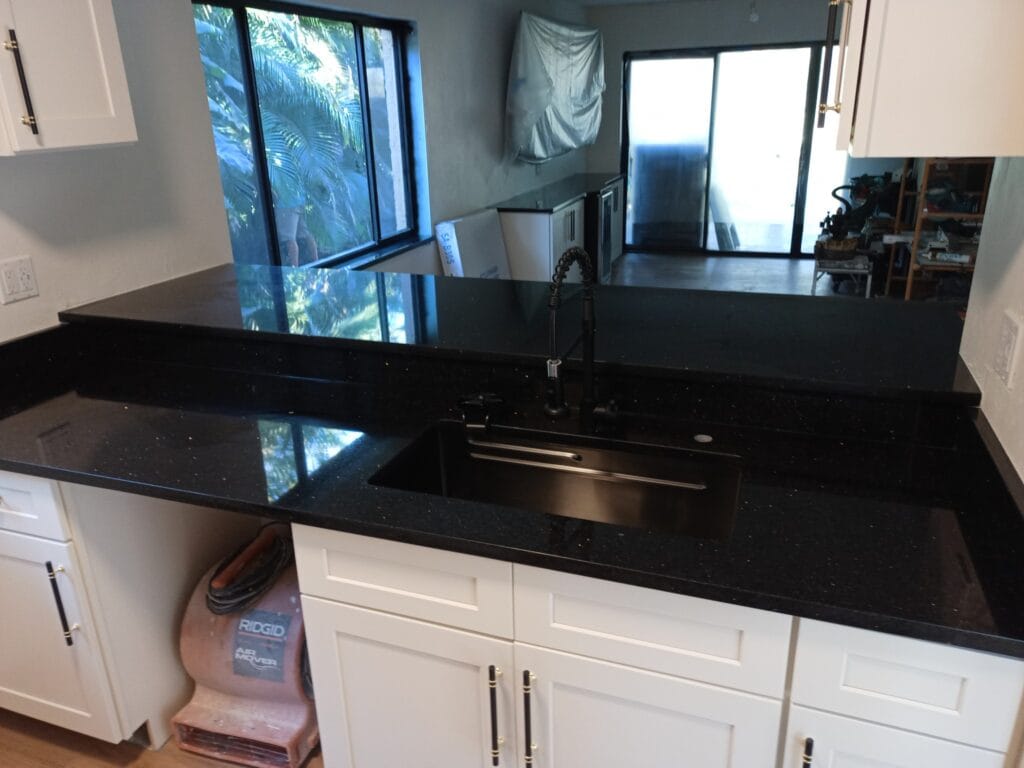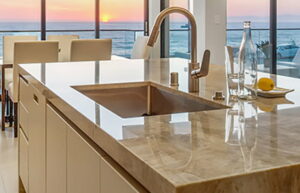When designing your kitchen or bathroom, countertops are one of the most visually prominent features. While much of the focus is often placed on the material and color of the countertops, the edge profile is an equally important detail that can make a significant impact on both the aesthetics and functionality of the space. The right edge profile can enhance the overall design, improve safety, and affect the long-term durability of your countertops. This guide will help you navigate the different edge profiles available and determine which one best suits your needs.
Countertop edge profiles are essentially the shape or design given to the outer edge of your countertop. From simple straight edges to more intricate ogee designs, each profile brings its own unique character to a room. Choosing the right edge profile is about balancing aesthetic preferences with practical considerations—whether you want a sleek, modern look, or an edge that is safer for a family with young children. By understanding the options available and considering how they will fit into your space, you can make a more informed decision that enhances both the style and functionality of your kitchen or bathroom.
In this article, we will explore the various types of countertop edge profiles, their aesthetic and functional implications, and how to choose the right one for your specific needs. Whether you’re undergoing a complete renovation or simply updating your countertops, this guide will provide you with the information you need to make the best choice.

Types of Countertop Edge Profiles
Countertop edge profiles come in a wide variety of shapes, each offering a unique look and function. The edge profile you choose will depend on your design preferences, how you use your countertops, and the overall style of your kitchen or bathroom. Below, we will provide an overview of some of the most popular edge profiles and discuss the pros and cons of each type.
Overview of Popular Edge Designs
There are many different types of countertop edge profiles, ranging from simple and sleek to ornate and decorative. Some of the most popular designs include:
- Straight Edge: A clean, modern look that works well with most design styles.
- Beveled Edge: Features a 45-degree angle cut, adding a touch of sophistication.
- Bullnose Edge: A rounded edge that provides a softer look and is family-friendly.
- Ogee Edge: An intricate, S-shaped profile that adds an elegant, traditional feel.
- Waterfall Edge: A dramatic edge that extends down the sides of the countertop for a contemporary statement.
Pros and Cons of Each Edge Type
Each edge profile has its own set of advantages and disadvantages. Here, we will examine the pros and cons of the most popular edge profiles:
- Straight Edge:
- Pros: Simple, clean, and versatile. Works well in both modern and traditional spaces.
- Cons: Can sometimes feel too sharp or industrial for more relaxed or cozy environments.
- Beveled Edge:
- Pros: Adds a subtle touch of elegance and works well with various countertop materials.
- Cons: The angled edge can be more prone to chipping compared to rounded edges.
- Bullnose Edge:
- Pros: Smooth and safe, making it an excellent choice for homes with children. The rounded edge also helps prevent chips.
- Cons: May not provide the sharp, clean lines desired in a modern kitchen design.
- Ogee Edge:
- Pros: Provides an ornate and decorative look, perfect for traditional or luxury kitchens.
- Cons: More difficult to clean and can be more expensive due to the intricate design.
- Waterfall Edge:
- Pros: Creates a bold, contemporary look by continuing the countertop material down the sides. Ideal for making a statement.
- Cons: Requires more material, making it more expensive. The sharp edge may also be a concern in households with young children.
Popular Edge Profiles Explained
Straight Edge: Modern Simplicity
The straight edge is one of the most popular choices for countertops, particularly in modern and minimalist designs. It features a clean, sharp edge that provides a sleek and sophisticated appearance. The straight edge works well with almost any type of countertop material, from granite to quartz, and it is versatile enough to complement both contemporary and traditional styles.
- Aesthetic Appeal: The straight edge offers a streamlined, minimalist look that enhances the sleekness of your countertops. It pairs well with modern cabinetry and simple kitchen decor.
- Functional Benefits: This edge is easy to clean and maintain, as it lacks intricate curves or grooves that can collect dust and debris. However, the sharp edge may be less forgiving in households with young children.
Beveled Edge: Classic Angles
The beveled edge is a classic design that features a 45-degree angle cut along the top edge of the countertop. This angled cut adds a touch of sophistication and can create interesting visual effects by catching light at different angles.
- Aesthetic Appeal: The beveled edge works well in both modern and traditional kitchens, adding a subtle detail that elevates the overall look of the space. It provides a refined, polished appearance that is less stark than the straight edge.
- Functional Benefits: The beveled edge is easier to clean than more intricate profiles but may be slightly more prone to chipping due to its angular shape. It is a great option for homeowners who want a decorative element without being too elaborate.
Bullnose Edge: Smooth and Safe
The bullnose edge is a fully rounded edge that creates a soft and smooth profile. It is a popular choice for family homes because of its safety features and classic look.
- Aesthetic Appeal: The bullnose edge gives countertops a softer, more approachable look, which makes it ideal for kitchens that aim for a warm and inviting feel. It works well with a variety of materials, including granite, marble, and quartz.
- Functional Benefits: This edge profile is one of the safest, as its rounded design helps prevent injuries from accidental bumps. It is also resistant to chipping, making it a durable choice for busy kitchens.
Ogee Edge: Elegant and Ornate
The ogee edge is an intricate, S-shaped profile that adds a touch of luxury and elegance to any countertop. This edge is often found in high-end, traditional kitchens and is perfect for those who want a statement piece.
- Aesthetic Appeal: The ogee edge is highly decorative and works well in traditional or luxury kitchen designs. It adds a sense of grandeur and sophistication, making it a focal point in the room.
- Functional Benefits: While the ogee edge is visually stunning, it can be more challenging to clean due to its intricate curves. It is also one of the more expensive edge profiles, both in terms of material and labor costs.
Waterfall Edge: Contemporary Statement
The waterfall edge is a dramatic and modern design that extends the countertop material down the sides of the cabinetry, creating a continuous flow. It is often used in contemporary kitchens to create a bold visual impact.
- Aesthetic Appeal: The waterfall edge creates a striking, seamless look that is perfect for making a statement. It works particularly well with natural stone materials, such as marble or granite, where the veining can be showcased in a continuous flow.
- Functional Benefits: This edge profile requires more material, which can make it more expensive. The sharp edge may also pose a safety concern in households with children, but it offers a unique and visually appealing option for modern kitchen designs.

Choosing the Right Edge for Your Material
Choosing the right edge profile for your countertop material is crucial to ensuring both aesthetic appeal and durability. Different materials have different characteristics, and certain edge profiles may be better suited to some materials than others. Below, we will explore how to choose the right edge for popular countertop materials such as granite, quartz, and marble.
Granite, Quartz, Marble, and Other Surfaces
- Granite: Granite is a durable and versatile material that works well with a wide range of edge profiles. Straight edges, beveled edges, and bullnose edges are popular choices for granite countertops. The natural veining and patterns in granite can be showcased beautifully with a simple edge profile like the straight or bullnose edge.
- Quartz: Quartz is an engineered stone that offers consistency in color and pattern, making it a great choice for modern and contemporary kitchens. Straight edges and waterfall edges are particularly popular for quartz countertops, as they enhance the clean lines and sleek look of the material. Quartz is also highly durable, so more intricate edges like the ogee can be used without worrying about chipping.
- Marble: Marble is known for its luxurious appearance and natural veining. Due to its softer nature, rounded edges like the bullnose or half bullnose are often recommended for marble countertops to reduce the risk of chipping. The ogee edge can also be used to enhance the elegance of marble, but it may require extra care to maintain.
- Other Materials: For other materials like laminate or solid surface countertops, edge profiles like the beveled or straight edge are often used. These materials are typically more affordable and can be easily customized to achieve a variety of looks. However, more intricate edges like the ogee may not be practical for laminate due to its composition.
Best Edge Options for Durability and Look
When choosing an edge profile, it’s important to consider both the durability of the material and the look you want to achieve. For high-traffic kitchens, rounded edges like the bullnose or half bullnose are ideal, as they are less prone to chipping and safer for families. For a more modern look, straight or waterfall edges are excellent choices that provide clean lines and a minimalist aesthetic.
If you are working with a softer material like marble, opting for a rounded edge will help prolong the lifespan of your countertops by reducing the risk of chips and cracks. For engineered materials like quartz, you have more flexibility in choosing an edge profile, as the material is less prone to damage.
Budget Considerations
When selecting a countertop edge profile, budget is an important factor to consider. The cost of different edge profiles can vary significantly depending on the complexity of the design, the material used, and the labor involved. Below, we will explore the cost differences between popular edge profiles and provide tips for balancing quality and affordability.
Cost Differences Between Edge Profiles
- Straight Edge: The straight edge is often the most cost-effective option, as it is simple to fabricate and requires minimal labor. It is a great choice for those looking to stay within a budget while still achieving a clean and modern look.
- Beveled Edge: The beveled edge is slightly more expensive than the straight edge due to the additional labor required to create the angled cut. However, it remains an affordable option that adds a touch of sophistication to your countertops.
- Bullnose Edge: The bullnose edge is moderately priced, making it a popular choice for homeowners who want a balance between aesthetics and affordability. Its rounded shape requires more material and labor than a straight edge but is still relatively budget-friendly.
- Ogee Edge: The ogee edge is one of the most expensive edge profiles due to its intricate design and the skill required to create it. The ogee edge is often used in luxury kitchens, and the higher cost reflects the level of craftsmanship involved.
- Waterfall Edge: The waterfall edge is also on the higher end of the cost spectrum, primarily because it requires additional material to extend the countertop down the sides of the cabinetry. This edge profile is ideal for those looking to make a bold statement, but it may not be the best option for those on a tight budget.
Balancing Quality and Affordability
To balance quality and affordability, consider the following tips when choosing a countertop edge profile:
- Prioritize Functionality: If you are working within a limited budget, prioritize functionality over intricate designs. Simple edge profiles like the straight or bullnose edge are often more affordable and still provide a great look for your countertops.
- Mix and Match: If you want to incorporate a more elaborate edge profile without exceeding your budget, consider using it in a smaller area, such as an island, while opting for a simpler edge on the rest of the countertops. This approach allows you to achieve a high-end look without the higher cost.
- Consult with Fabricators: Talk to your countertop fabricator about your budget and design goals. They can help you choose an edge profile that fits your budget while still providing the aesthetic you want. Fabricators may also have suggestions for cost-effective alternatives that achieve a similar look.

Practical Tips for Making Your Decision
Choosing the right countertop edge profile involves more than just selecting a style you like. There are practical steps you can take to ensure that the edge profile you choose is the best fit for your space, budget, and lifestyle. Here are some practical tips to help you make your final decision:
Consulting with Professionals
One of the best ways to ensure that you choose the right edge profile is to consult with a professional. Countertop fabricators and interior designers have extensive experience with different edge profiles and can provide valuable insight into which options will work best for your specific needs. They can help you assess factors like material compatibility, safety, and cost, and they may also have suggestions you haven’t considered.
When consulting with a professional, be sure to communicate your design preferences, budget, and lifestyle requirements. A professional can guide you toward an edge profile that meets your needs while also complementing the overall style of your kitchen or bathroom.
Testing Edge Samples in Your Space
Another important step in the decision-making process is to test edge samples in your space. Many countertop fabricators provide edge profile samples that you can take home to see how they look in your kitchen or bathroom. Testing samples in your actual space allows you to see how the edge profile will look under different lighting conditions and against your existing cabinetry and decor.
When testing edge samples, consider both the look and feel of each profile. Run your hand along the edge to get a sense of how comfortable it feels, especially if you have young children who may be at counter height. Also, think about how each edge profile will interact with other elements in the room, such as cabinet handles and appliances.
Considering Long-Term Use and Maintenance
Think about how you will use your countertops on a daily basis and choose an edge profile that will meet your long-term needs. For example, if you frequently cook and use heavy pots and pans, you may want to choose an edge profile that is less prone to chipping, such as a bullnose or rounded edge. If you have young children, a rounded edge may be safer than a sharp, angular edge.
Maintenance is another important factor to consider. More intricate edge profiles, such as the ogee, may require more effort to keep clean, as dust and debris can collect in the curves. If low maintenance is a priority for you, opt for a simpler edge profile that is easier to clean and maintain.
Balancing Aesthetic and Practical Needs
It’s important to strike a balance between aesthetics and practicality when choosing a countertop edge profile. While you may be drawn to a particular edge profile for its visual appeal, consider whether it will also meet your functional needs. For example, a waterfall edge may look stunning in a modern kitchen, but it may not be the most practical choice for a family with young children due to its sharp corners.
Take the time to weigh the pros and cons of each edge profile, and don’t be afraid to ask questions. Ultimately, the right edge profile is one that not only enhances the look of your space but also works well for your lifestyle and budget.
Conclusion
Choosing the right countertop edge profile is a crucial step in the design process, as it can greatly influence both the aesthetics and functionality of your kitchen or bathroom. By understanding the various types of edge profiles available, their pros and cons, and how they interact with different countertop materials, you can make an informed decision that enhances the beauty and practicality of your space.
Whether you are drawn to the clean lines of a straight edge, the classic elegance of a beveled edge, the safety of a bullnose edge, the ornate details of an ogee edge, or the bold statement of a waterfall edge, each profile has unique features that can elevate the overall look and feel of your countertops. Consider your lifestyle, budget, and design preferences when making your choice, and remember that consulting with professionals and testing edge samples in your space can help you make the best decision.
Ultimately, the goal is to find an edge profile that brings together aesthetic appeal and functional benefits, creating a countertop that not only looks beautiful but also meets your everyday needs. With the right edge profile, you can achieve a cohesive and stylish finish that adds value and enjoyment to your home.





